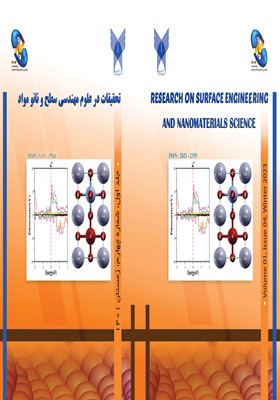یافتن تابع تاثیرجهت محاسبه ضرایب شدت تنش برای محور دارای ترک محیطی سطحی تحت بارگذاری پیچشی ناگهانی
محورهای موضوعی : تحقیقات در علوم مهندسی سطح و نانو موادبهروز آرین نژاد 1 , شهرام شهروئی 2 , محمد شیشه ساز 3
1 - گروه مهندسی مکانیک، واحد اهواز، دانشگاه آزاد اسلامی، اهواز، ایران
2 - گروه مهندسی مکانیک، واحد اهواز، دانشگاه آزاد اسلامی، اهواز، ایران
3 - گروه مهندسی مکانیک، دانشگاه شهید چمران اهواز، اهواز، ایران
کلید واژه: تابع تاثیر, ضریب شدت تنش ضربه ای, ترک محیطی سطحی, روش بدون المان درو ن یابی نقطه ای شعاعی, بارگذاری ناگهانی پیچشی,
چکیده مقاله :
در این مقاله با رویکردی نوین با بهره گیری از روش بدون المان درو ن یابی نقطه ای شعاعی ، به تعیین تابع تاثیر مورد استفاده جهت یافتن ضرایب شدت تنش ناشی از بارگذاری پیچشی ناگهانی در محور دارای یک ترک محیطی سطحی اولیه پرداخته شده است. با یافتن تابع تاثیر که مستقل از جنس سازه بوده محاسبه ضرایب شدت تنش برای تحلیلگر تا سر حد امکان ساده خواهد شد. برای این منظور ابتدا مقادیر تنش در صفحه ترک به روش منحنی مشخصه فضا - زمان لاگرانژ در بازه های زمانی متوالی در لحظه تثبیت مقدار موج گشتاور پیچشی اعمالی محاسبه گردیده است. سپس با تحلیل عددی، میدان های جابجایی، تنش و کرنش در نقاط گره ای سطح مقطع ترکدار تعیین و مقادیر ضریب شدت تنش ضربه ای یافت شده اند. در نهایت با استفاده از روش انطباق منحنی ها و نتایج ناشی از مقایسه ضرایب شدت تنش استاتیکی ، دینامیکی با بارگذاری ناگهانی تابع تاثیر یافت گردید. یافته ها ی تحقیق نشان می دهند، مقادیر ضرایب شدت تنش ناشی از لحظات اولیه بارگذاری یا ضربه ای نسبت به ضرایب شدت حاصل از بار گذاری استاتیکی و دینامیکی بیشتر هستند مضاف اینکه به دلیل کوتاه بودن زمان بارگذاری ضربه ای ، تنش ناشی از آن را باید بعنوان یک تنش اولیه، در کنار بارگذاری استاتیکی در محاسبات فرض نمود و با لحاظ آن نرخ رشد ترک را دقیق تر تخمین زد.
[1] H .Tada, P.C .Paris, G.R. Irwin, The stress analysis of cracks. Del Research Corp, Hellertown PA, 1973.
[2] A.W. Maue, Die Entspannungswelle bei plötzlichem Einschnitt eines gespannten elastischen Körpers. Applied Mathematics and Mechanics/Zeitschrift für Angewandte Mathematik und Mechanik, 1-2 (1954) 1-12.
[3] AT. De Hoop, Representation theorems for the displacement in an elastic solid and their application to elastodynamic diffraction theory. 1958.
[4] R.J. Ravera, G.C. Sih, Transient analysis of stress waves around cracks under antiplane strain. The Journal of the Acoustical Society of America, 3B (1970) 875-881.
[5] G.C. Sih, G.T. Embley, R.S. Ravera, Impact response of a finite crack in plane extension. International Journal of Solids and Structures, 7 (1972) 977-993.
[6] MK. Miller, WT .Guy. Jr, Numerical inversion of the Laplace transform by use of Jacobi polynomials. SIAM Journal on Numerical Analysis, 4 (1966) 624-635.
[7] AG. Evans, ME .Gulden, M .Rosenblatt. Impact damage in brittle materials in the elastic-plastic response regime. in Proceedings of the Royal Society of London A: Mathematical, Physical and Engineering Sciences. 1978.
[8] S.A. Thau, L .Tsin-Hwei, Transient stress intensity factors for a finite crack in an elastic solid caused by a dilatational wave. International Journal of Solids and Structures, 7 (1971) 731-750.
[9] GR. Liu, YT. Gu," A point interpolation method for two-dimensional solids". International Journal for Numerical Methods in Engineering, 4(2001) 937-951.
[10] J.G. Wang, G.R. Liu, " Radial point interpolation method for elastoplastic problems". in ICSSD: 1 st Structural Conference on Structural Stability and Dynamics. 2000.
[11] J.G. Wang, G.R. Liu, " A point interpolation meshless method based on radial basis functions". International Journal for Numerical Methods in Engineering, 11(2002) 1623-1648.
[12] Y.T. Gu, W .Wang, L.C. Zhang, X.Q. Feng, An enriched radial point interpolation method (e-RPIM) for analysis of crack tip fields. Engineering Fracture Mechanics, 1(2011) 175-190.
[13] A. Moussaoui, T. Bouziane, Numerical study of the shape parameter dependence of the local radial point interpolation method in linear elasticity. MethodsX, 3 (2016) 178-187.
[14] A. Afsari, M .Movahhedi, Criterion for selecting the shape functions in electromagnetic meshless methods, IET Science, Measurement & Technology, 3 (2013) 157-165.
[15] O.Y. Bozkurt, B. Kanber, M.Z. AŞIK, Assessment of RPIM shape parameters for solution accuracy of 2D geometrically nonlinear problems. International Journal of Computational Methods, 3 (2013) 1350003.
[16] H. Ghaffarzadeh, M. Barghian, A. Mansouri, M Sadeghi, Study on meshfree hermite radial point interpolation method for flexural wave propagation modeling and damage quantification. Latin American Journal of Solids and Structures, 13 (2016) 2606-2627.
[17] E.Shivanian, Formulation of pseudospectral meshless radial point Hermit interpolation for the Motz problem and comparison to pseudospectral meshless radial point interpolation, Multidiscipline Modeling in Materials and Structures. Multidiscipline Modeling in Materials and Structures, 1 (2020) 1-20.
[18] Y. Li, G.R. Liu ., An element-free smoothed radial point interpolation method (EFS-RPIM) for 2D and 3D solid mechanics problems. Computers & Mathematics with Applications, 2 (2019) 441-465.
[19] A.I. Pais, J.L. Alves, J. BelinhaUsing a radial point interpolation meshless method and the finite element method for application of a bio-inspired remodelling algorithm in the design of optimized bone scaffold. Journal of the Brazilian Society of Mechanical Sciences and Engineering, 12 (2021):1-15.
[20] B. Ariannezhad, S Shahrooi, M. Shishehsaz. On applicability of MQ-RPIM and MLPG meshless methods with 3D extended-enriched base functions for estimation of mode I stress intensity factor and fatigue crack growth in cyclic tensile and bending load of an un-notched and notched shaft. The Journal of Strain Analysis for Engineering Design, 5 (2022) 340-359.
[21] D.C Ramalho, J. Belinha, R. Campilho. The numerical simulation of crack propagation using radial point interpolation meshless methods. Engineering Analysis with Boundary Elements. 109 (2019) 187-198.
[22] O. Askour, S. Mesmoudi, B. Braikat , On the use of Radial Point Interpolation Method (RPIM) in a high order continuation for the resolution of the geometrically nonlinear elasticity problems. Engineering Analysis with Boundary Elements. 110 (2020) 69-79.


